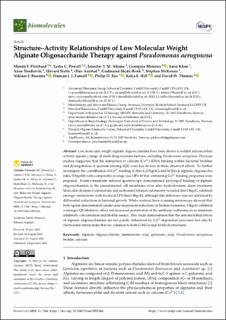| dc.contributor.author | Pritchard, Manon F. | |
| dc.contributor.author | Powell, Lydia C. | |
| dc.contributor.author | Adams, Jennifer Y. M. | |
| dc.contributor.author | Menzies, Georgina | |
| dc.contributor.author | Khan, Saira | |
| dc.contributor.author | Tøndervik, Anne | |
| dc.contributor.author | Sletta, Håvard | |
| dc.contributor.author | Aarstad, Olav Andreas | |
| dc.contributor.author | Skjåk-Bræk, Gudmund | |
| dc.contributor.author | McKenna, Stephen | |
| dc.contributor.author | Buurma, Niklaas J. | |
| dc.contributor.author | Farnell, Damian J. J. | |
| dc.contributor.author | Rye, Philip D. | |
| dc.contributor.author | Hill, Katja E. | |
| dc.contributor.author | Thomas, David W. | |
| dc.date.accessioned | 2024-02-08T08:32:32Z | |
| dc.date.available | 2024-02-08T08:32:32Z | |
| dc.date.created | 2023-10-06T14:52:35Z | |
| dc.date.issued | 2023 | |
| dc.identifier.citation | Biomolecules. 2023, 13 (9), . | en_US |
| dc.identifier.issn | 2218-273X | |
| dc.identifier.uri | https://hdl.handle.net/11250/3116293 | |
| dc.description.abstract | Low molecular weight alginate oligosaccharides have been shown to exhibit anti-microbial activity against a range of multi-drug resistant bacteria, including Pseudomonas aeruginosa. Previous studies suggested that the disruption of calcium (Ca2+)–DNA binding within bacterial biofilms and dysregulation of quorum sensing (QS) were key factors in these observed effects. To further investigate the contribution of Ca2+ binding, G-block (OligoG) and M-block alginate oligosaccharides (OligoM) with comparable average size DPn 19 but contrasting Ca2+ binding properties were prepared. Fourier-transform infrared spectroscopy demonstrated prolonged binding of alginate oligosaccharides to the pseudomonal cell membrane even after hydrodynamic shear treatment. Molecular dynamics simulations and isothermal titration calorimetry revealed that OligoG exhibited stronger interactions with bacterial LPS than OligoM, although this difference was not mirrored by differential reductions in bacterial growth. While confocal laser scanning microscopy showed that both agents demonstrated similar dose-dependent reductions in biofilm formation, OligoG exhibited a stronger QS inhibitory effect and increased potentiation of the antibiotic azithromycin in minimum inhibitory concentration and biofilm assays. This study demonstrates that the anti-microbial effects of alginate oligosaccharides are not purely influenced by Ca2+-dependent processes but also by electrostatic interactions that are common to both G-block and M-block structures. | en_US |
| dc.language.iso | eng | en_US |
| dc.publisher | MDPI | en_US |
| dc.rights | Navngivelse 4.0 Internasjonal | * |
| dc.rights.uri | http://creativecommons.org/licenses/by/4.0/deed.no | * |
| dc.title | Structure–Activity Relationships of Low Molecular Weight Alginate Oligosaccharide Therapy against Pseudomonas aeruginosa | en_US |
| dc.title.alternative | Structure–Activity Relationships of Low Molecular Weight Alginate Oligosaccharide Therapy against Pseudomonas aeruginosa | en_US |
| dc.type | Peer reviewed | en_US |
| dc.type | Journal article | en_US |
| dc.description.version | publishedVersion | en_US |
| dc.source.pagenumber | 17 | en_US |
| dc.source.volume | 13 | en_US |
| dc.source.journal | Biomolecules | en_US |
| dc.source.issue | 9 | en_US |
| dc.identifier.doi | 10.3390/biom13091366 | |
| dc.identifier.cristin | 2182503 | |
| dc.relation.project | Norges forskningsråd: 281920 | en_US |
| dc.relation.project | EU/6628 | en_US |
| cristin.ispublished | true | |
| cristin.fulltext | original | |
| cristin.qualitycode | 1 | |

